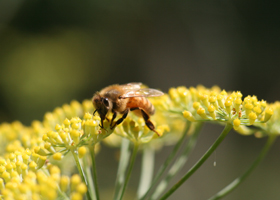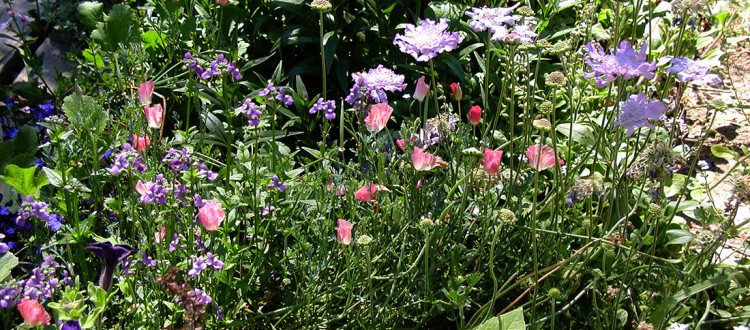Welcoming Bees into Your Garden
Early summer I was in the garden looking at my flowering shrubs and found them thrumming with activity. Tiny black wasps, ladybugs and lots of bees were thrilled with the nectar that my flowering plants were providing. Now that the seasonal blooms have dwindled, I have noticed the populations have diminished.
Climate change and drought have affected the ability of wild plants to bloom over a long season, and natural springs and other water sources, such as fountains or birdbaths, have dried up, making it a challenge for these insects to survive, much less thrive. By providing nectar sources, not only will you be inviting bees into your garden, it will also attract other pollinators such as hummingbirds, butterflies, and other beneficial insects and natural enemies of garden pests, such as parasitic wasps and lace wings.
 My unusual permanent plantings include Angelica archangelica. The sturdy umbels sport tiny plain flowers with an abundance of nectar. The large, deep dusty blue spikes of the Chaste tree (Vitex agnus-castus) attracted both the hummingbirds and the bees. The fragrant blue flowers were intermingled with the umbelliferous flowers of a wild leaf fennel, and there I observed a beautiful dance of feeding creatures. Nearby the enticing African Blue basil, Fiorentino zucchini, and Crystal Apple cucumbers, played host to the insects as well. I also observed bees in the roses, on the alyssum, oregano, and sweet marjoram flowers.
My unusual permanent plantings include Angelica archangelica. The sturdy umbels sport tiny plain flowers with an abundance of nectar. The large, deep dusty blue spikes of the Chaste tree (Vitex agnus-castus) attracted both the hummingbirds and the bees. The fragrant blue flowers were intermingled with the umbelliferous flowers of a wild leaf fennel, and there I observed a beautiful dance of feeding creatures. Nearby the enticing African Blue basil, Fiorentino zucchini, and Crystal Apple cucumbers, played host to the insects as well. I also observed bees in the roses, on the alyssum, oregano, and sweet marjoram flowers.
Plant Trees, Shrubs and Flowers That Pollinators Love
Staggered plantings for a year-round nectar source include annuals with multiple flower heads such as alyssum, or flower spikes such as salvia. Include umbelliferous annuals and perennials such as dill, Queen Anne’s lace, coriander, chervil, angelica and leaf fennel, along with native wildflowers and clover. Nectar rich flowers for late fall include flowering shrubs such as viburnum, escalonia, grevillia and bottle brush. Echinacea, gaillardia and rudbeckia are also some good late blooming perennials to consider.
Create a Place for Bees to Nest
Native bees are solitary and often nest in the soft wood of rotting logs, or even in the deep cracks of redwood bark. Other species nest in the ground. You can provide loosely packed mounds for them when you are creating garden beds or ponds. Don’t use neonictinoid products that have been shown to harm bees for controlling garden pests. Round Up should not be used as the chemical stays in the environment, contaminating water.
When it’s hot and dry, provide a water source for the bees. As blossoms wane in late summer, the nectar sources that provide sustenance become scarce. A deep tray or over sized plant saucers (clay or glazed ceramic from the garden center or a thrift shop) can be filled regularly. Be sure to add two or three “landing rocks” for the bees!
For Further Reading
For more information about building a bee habitat including a garden plan, the UC Berkeley Urban Bee Lab website is a wonderful resource.
See Sunset’s article: Plant a Pollinator Garden to Get Bees, Hummingbirds, and Butterflies Buzzing
See Sunset’s article: The 22 Best Plants for Bees

